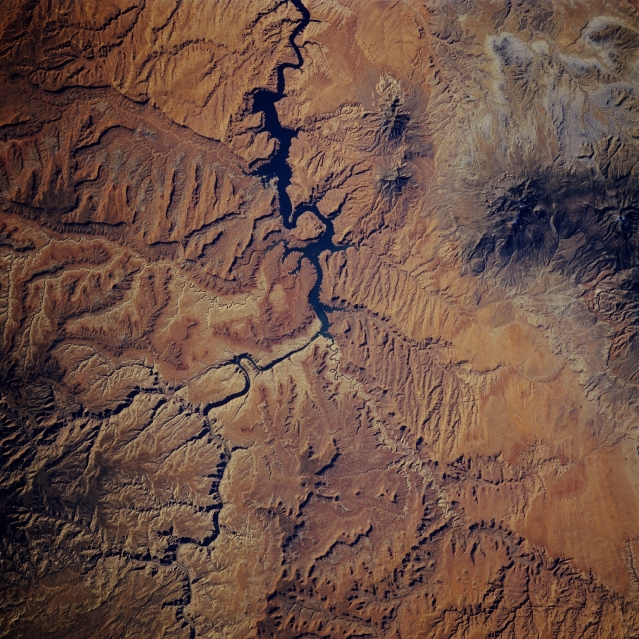
 Photo #: STS61A-48-92 Date: Nov. 1985
Photo #: STS61A-48-92 Date: Nov. 1985Geographic Region: USA-UTAH
Feature: LAKE POWELL

 Photo #: STS61A-48-92 Date: Nov. 1985 Photo #: STS61A-48-92 Date: Nov. 1985Geographic Region: USA-UTAH Feature: LAKE POWELL |
 |
| STS61A-048-0092 Lake Powell and Colorado River, Utah, U.S.A. November 1985 This southwest-looking, low-oblique photograph features the Colorado River, the northern portion of Lake Powell, and the merging of the Dirty Devil River with Lake Powell. Visible are the dark Henry Mountains; part of the Colorado Plateau Region, with numerous canyons, plateaus, and flat-topped mesas; and colorful orange and red rocks. Most of the region displayed is part of Canyonlands National Park and Glen Canyon National Recreation Area. |
| Images: | All Available Images Low-Resolution 407k |
|
| Mission: | STS61A |
|
| Roll - Frame: | 48 - 92 |
|
| Geographical Name: | USA-UTAH |
|
| Features: | LAKE POWELL |
|
| Center Lat x Lon: | 38.0N x 110.5W |
|
| Film Exposure: | N | N=Normal exposure, U=Under exposed, O=Over exposed, F=out of Focus |
| Percentage of Cloud Cover-CLDP: | 0 |
|
| Camera:: | HB |
|
| Camera Tilt: | 4 | LO=Low Oblique, HO=High Oblique, NV=Near Vertical |
| Camera Focal Length: | 250 |
|
| Nadir to Photo Center Direction: | SW | The direction from the nadir to the center point, N=North, S=South, E=East, W=West |
| Stereo?: | N | Y=Yes there is an adjacent picture of the same area, N=No there isn't |
| Orbit Number: | 65 |
|
| Date: | 19851103 | YYYYMMDD |
| Time: | 181430 | GMT HHMMSS |
| Nadir Lat: | 38.1N |
Latitude of suborbital point of spacecraft |
| Nadir Lon: | 110.3W |
Longitude of suborbital point of spacecraft |
| Sun Azimuth: | 164 | Clockwise angle in degrees from north to the sun measured at the nadir point |
| Space Craft Altitude: | 179 | nautical miles |
| Sun Elevation: | 35 | Angle in degrees between the horizon and the sun, measured at the nadir point |
| Land Views: | PLATEAU, MOUNTAIN |
|
| Water Views: | LAKE, RIVER |
|
| Atmosphere Views: | |
|
| Man Made Views: | |
|
| City Views: | |
|
Photo is not associated with any sequences | ||
| NASA Home Page |
JSC Home Page |
JSC Digital Image Collection |
Earth Science & Remote Sensing |
|
|